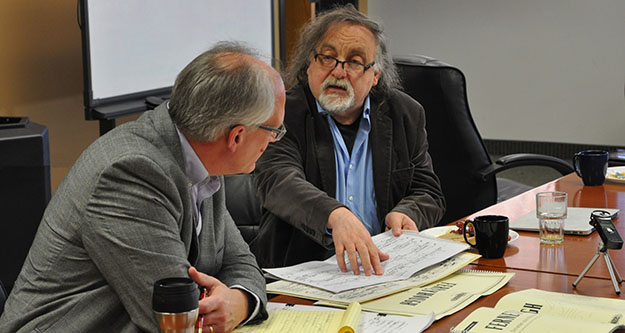 L to R: Mark Adler, Brian Ferneyhough
L to R: Mark Adler, Brian Ferneyhough
Renowned composer and longtime Finale user Brian Ferneyhough visited the MakeMusic offices in late March. The composer was in town participating in a residency at the University of Minnesota. Ferneyhough agreed to take time out of his schedule to sit down with Sr. Music Editor Mark Adler and Notation Product Manager Yvonne Grover to discuss notation issues related to contemporary and avant-garde music. Prof. Ferneyhough was accompanied by seven graduate composers from the U of MN who also participated in the discussion.
Since the mid-1970s, Ferneyhough has been recognized as “one of the most influential creative personalities and significant musical thinkers on the contemporary scene.” (Edition Peters Website) The composer is known for his highly complex and musically dense scores. As indicated by Mark Adler, “Many of Prof. Ferneyhough’s works are well known for the technical demands placed on the performer, but there are huge technical demands placed on notation products and engravers as well.”
During the two hour discussion, Ferneyhough walked through his process of incorporating music generational programs, like OpenMusic and Patchwork (PWGL), into his compositional process and the use of these programs in combination with Finale:
“The way I work at the moment is, perhaps, of some relevance. I have two screens. On one screen I have a music calculation program, which is usually PatchWork GL or OpenMusic. On these I calculate rhythms, chords, and densities. I can take the rhythmic notation and, using OpenMusic Syntax, port it to Finale. I clean it up in Finale, and I can add a pitch layer. I don’t do everything at once as a rule. I’m a layer man.”
Regarding his workflow and working from sketch to score, Ferneyhough said that he does not work from a fully realized handwritten sketch to a full score. While he will sometimes write out fragments of compositions, he largely works directly into the computer:
“My flow of paper is radically diminished. On the one screen, I can set up whatever element of the music I’m dealing with at the moment, let’s say rhythmic density, and I can transfer that to a first stage full score. It’s just got the rhythms in it, or some rhythms in it. And then you simply add different layers on top of that until you get the final product… Finale’s facility for interfacing with other music generational programs is important.”
In addition to discussing workflow issues and font capabilities, Ferneyhough and the student composers voiced their desire for support of advanced techniques in notation programs, such as micro-tonal support and support for uncommon time signatures. The composer commented that, “there has been a discussion of so-called irrational time signatures, such as 3/12 or 9/17. OpenMusic and Patchwork can implement any denominator, and I see no reason why Finale can’t do the same thing.”
The conversation with Prof. Ferneyhough and the U of MN composition students was extremely productive for the leaders of the Finale development team. As Finale development looks towards the future, comments and concerns from users such as these are crucial to the evolution of the program. As stated by Adler, “We see events such as this as an important part of Finale development. Meeting with composers and artists at the forefront of musical innovation is an essential component for growth in the field of music notation.”
More information about Brian Ferneyhough, including examples of Brian Ferneyhough’s handwritten and Finale scores, video interviews, and audio links, can be found on the Editions Peters website: